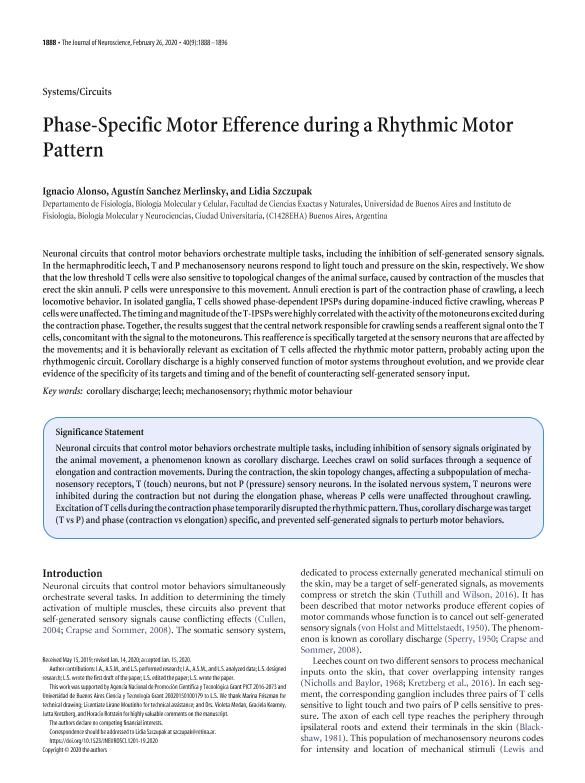Artículo
Phase-specific motor efference during a rhythmic motor pattern
Fecha de publicación:
02/2020
Editorial:
Society for Neuroscience
Revista:
Journal of Neuroscience
ISSN:
0270-6474
Idioma:
Inglés
Tipo de recurso:
Artículo publicado
Clasificación temática:
Resumen
Neuronal circuits that control motor behaviors orchestrate multiple tasks, including the inhibition of self-generated sensory signals. In the hermaphroditic leech, T and P mechanosensory neurons respond to light touch and pressure on the skin, respectively. We show that the low threshold T cells were also sensitive to topological changes of the animal surface, caused by contraction of the muscles that erect the skin annuli. P cells were unresponsive to this movement. Annuli erection is part of the contraction phase of crawling, a leech locomotive behavior. In isolated ganglia, T cells showed phase-dependent IPSPs during dopamine-induced fictive crawling, whereas P cells were unaffected. The timing and magnitude of the T-IPSPs were highly correlated with the activity of the motoneurons excited during the contraction phase. Together, the results suggest that the central network responsible for crawling sends a reafferent signal onto the T cells, concomitant with the signal to the motoneurons. This reafference is specifically targeted at the sensory neurons that are affected by the movements; and it is behaviorally relevant as excitation of T cells affected the rhythmic motor pattern, probably acting upon the rhythmogenic circuit. Corollary discharge is a highly conserved function of motor systems throughout evolution, and we provide clear evidence of the specificity of its targets and timing and of the benefit of counteracting self-generated sensory input.
Palabras clave:
mecanosensorial
,
descarga corolaria
,
osciladores
,
Hirudo
Archivos asociados
Licencia
Identificadores
Colecciones
Articulos(IFIBYNE)
Articulos de INST.DE FISIOL., BIOL.MOLECULAR Y NEUROCIENCIAS
Articulos de INST.DE FISIOL., BIOL.MOLECULAR Y NEUROCIENCIAS
Citación
Alonso, Ignacio; Sanchez Merlinsky, Agustín; Szczupak, Lidia; Phase-specific motor efference during a rhythmic motor pattern; Society for Neuroscience; Journal of Neuroscience; 40; 9; 2-2020; 1888-1896
Compartir
Altmétricas




